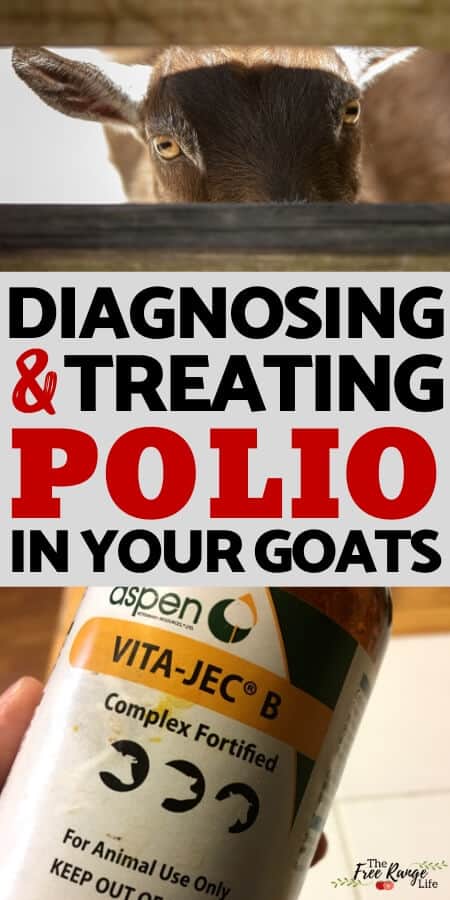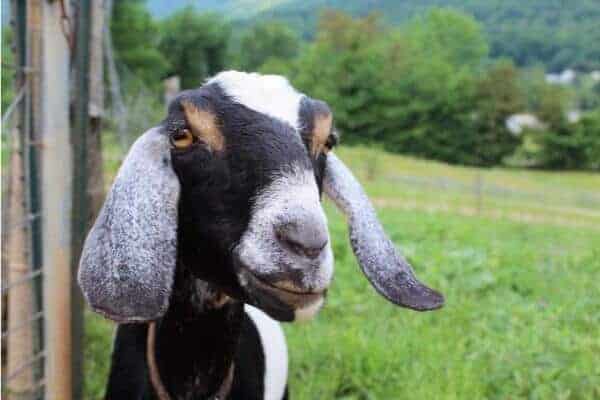If you have a sick goat showing neurological symptoms you might be dealing with goat polio. Learn more about what goat polio is and how to treat it successfully.
A few years ago we had a couple of goats escape from their pen and spend the day up in the woods. The next day those same goats didn’t look too well.
This site contains affiliate links. If you make a purchase using one of these links, I may earn a commission. Please see my disclosure page for more information about cookies collected and our privacy policy.
They were off in a corner and swaying on their feet.
We were actually dealing with 2 things- plant toxicity from munching on holly berries and goat polio.
Goat polio sounds pretty scary, and it is a serious condition that needs to be treated immediately.
How to Diagnose and Treat Goat Polio
First off what is goat polio? The actual name for the condition is Polioencephalomalacia, and it is caused by a thiamine (Vitamin B1) deficiency in goats.
Now compared to goat polio, thiamine deficiency sounds like a simple fix, right?
But it’s actually a life threatening condition that can be deadly if not diagnosed and treated quickly.
What causes goat polio
Goat polio is a metabolic disease. This thiamine deficiency is brought on by a disruption in the rumen.
Any change in the rumen’s environment that changes the normal bacteria activity can cause a disruption in the goats natural thiamine production.
Causes of goat polio include things like:
- Feeding too much grain
- Improper feeding program
- Feeding moldy hay or grain
- Sudden diet changes (new forage, weaning, escaping)
- Reactions to some medications
Each of these things can cause a change in the natural balance of the rumen, throwing it off balance, and disrupting thiamine production.
Symptoms of Goat Polio
So how do you know if you’re dealing with goat polio?
Thiamine is critical for your goats to metabolize glucose. It’s also an important part of brain function (which relies on glucose).
If a goat is deficient in thiamine neurological symptoms are usually present. Symptoms such as:
- Stargazing
- Staggering
- Circling
- Muscle spasms
- Head arched back onto the back
- Blindness
- Convulsions
If you see any of these symptoms, it’s best to start treatment for goat polio right away.
How to Treat Goat Polio
If left untreated a goat with goat polio can die in as little as 24-72 hours. Goats with polioencephalomalacia who are treated early have a good chance of making a complete recovery.
Treating goat polio is done through dosing high amount of thiamine.
You can give thiamine in two different ways:
FORTIFIED Vitamin B Complex: Note this MUST be labeled fortified and have at least 100mg/mL of Vitamin B1/Thiamine in it.
Fortified Vitamin B Complex is available over-the-counter and all goat owners should keep this supplement on hand at all times.
Inject your goat with 4cc/100lbs of fortified B complex 2-3 times a day. Reducing to once per day as the goat shows improvement in symptoms.
Concentrated Injectable Vitamin B1: This has a higher concentration of thiamine but is only available through a vet’s prescription.
Your vet will be able to give you the dosage amount, but treatment will be similar to above. Give injections 2 times per day at first and then reduce to once per day as the goat shows improvement.
Note that Thiamine, and all B-Vitamins, are water soluble and your goat will eliminate the excess in her urine. This makes it very hard to overdose on Vitamin B.
*Read below for information on Listeriosis and Polio together.
Anti-Inflammatories such as Banamine or Dexamethasone can also be given to aid in recovery.
I also like to give a dose of Probios after any illness to help recover the rumen function.
Preventing Polioencephalomalacia in Your Goats
Goat polio is almost always caused by improper feeding- whether intentional or unintentional.
The best way to prevent goat polio is to ensure a proper diet.
This means you are feeding your goats the correct balance of grain, forage, and hay.
You can read my article on goat nutrition for more information or get my Goat Management Binder which includes a complete guide to goat nutrition.
Always check your hay and feed for mold before feeding to your goats. Mold isn’t good for anyone to ingest, make sure to check each and every time you feed just in case.
Make sure you have a strong fence in your goat pen. Sometimes goat polio is caused when a goat escapes from their yard, thus creating a change in diet.
It’s not always from eating toxic plants, but by eating a vast amount of green material that is new to the goat’s system. Or the goat could accidentally get into the grain bin (or chicken grain bin) while they are out of their yard.
Read more on fencing for goats:
How to Use Electric Fencing for Goats
Goat Polio or Listeriosis??
Unfortunately there’s another illness that closely mimics goat polio in symptoms, and that’s listeriosis.
Listeriosis also causes neurological symptoms and is often caused by a rumen upset as well.
So how can you tell the difference between these two diseases and how do you know how to treat?
Well, you have a couple of options:
- Treat them both.
- Treat for one and then the other if the first treatment doesn’t help.
Listeriosis is treated with an antibiotic- usually Procaine Penicillin or Oxytetracycline- given 2 times per day. Listeriosis is very hard to recover from.
There are many goat breeders that treat for both with great results, and it’s one of your options if you see these symptoms in your goats.
Treat with both Thiamine and antibiotics at the same time.
If you dislike the idea of giving antibiotics without need, you can choose to treat for Goat Polio first.
If there is no change at all in symptoms after 1-2 doses then you should start treatment for listeriosis as well.
Goat polio can be fatal if not caught and treated quickly. The main takeaways from this article should be:
- Make sure your goats are being fed properly and don’t have a high-grain diet.
- Have strong fences and keep all grain and feed bins in an inaccessible area.
- Always have a bottle of Fortified Vitamin B Complex on hand.
More Goat Health Articles:
How to Treat and Diagnose Coccidiosis
How to Treat and Diagnose Anemia in Goats
Or check out the Complete Quickstart Guide to Raising Goats for a comprehensive overview.








Very useful and clear.
Thanks.
Hi sara
Very useful point
Likely,This diseàe is depended to some breed like sanen.isnt it?
My had buck recovered from what i suspected Polio he’s eating good but unfortunately still cant move/stand legs behind. is there any chance for to be fully well if i give him more Thiamine? thanks for reply.